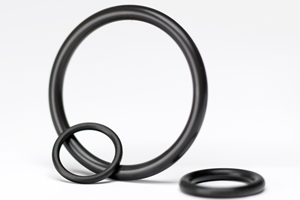Article re-posted with permission from Parker Hannifin Sealing & Shielding Team.
Original content can be found on Parker’s Blog.
Lubrication is an important, sometimes overlooked, component of sealing. Many applications require lubrication for installation to prevent seal damage and prevent injury during manual assembly. Internal lubricants reduce installation force and dynamic friction without the need for an external lubricant or coating. Internal lubrication also decreases break-out friction for dynamic applications. Operating seals with no lubrication can lead to heat buildup and accelerated wear that can result in leakage and shorten the seal’s life. Internally lubricated seal materials provide a clean alternative to grease or oil in an assembly operation.
How an internally lubricated o-ring works
Internal lubrication works by incorporating friction reducing ingredients into the elastomer formula. These friction-reducing components can include organic materials such as graphite, molybdenum disulfide, powdered PTFE or proprietary Parker internal lubricant ingredients. Internal lubricant is dispersed throughout the body of an O-ring with a waxy consistency.

Over the life of an internally lubricated seal, the lubricant can gradually make its way to the surface or bloom, lasting longer than a coating that can rub off or applying an external lubricant to the surface of the seal. Theoretically, the internal lubricant could “wear out” but this has rarely been reported in the field.
Internally vs. externally lubricated O-rings
Sometimes, internally lubricated materials perform better than externally lubricated O-rings. Though external lubricants are more effective at lowering the coefficient of friction than internal lubricants, there are some drawbacks. External lubricants are messy. They add an extra step in the assembly process and can interrupt automation. External lubricants are not an option for all applications as lubricants can harbor contaminants and bacteria in some environments. Powders, dirt and other particulates can stick to external lubricants, decreasing the performance of the seal. Additional alternatives are PTFE or ParkerSlick coatings. However, these types of coatings are non-permanent and can flake off with abrasion or during service. These coating flakes could clog small orifices such as gasoline fuel injectors. Internal lubrication can be the clean solution in these cases.
Parker's internally lubricated materials
Parker offers internally lubricated compounds in many material families including Nitrile (NBR), Vamac® (AEM), Neoprene (CR), Ethylene Propylene (EPDM), and Fluorocarbon (FKM). Internally lubricated materials maintain the same chemical compatibility and high temperature resistance as the basic materials. These materials are used across a variety of fields including General Industrial, Life Sciences, Automotive, and more. Our catalog includes internally lubricated materials with a variety of certifications for specific applications including NSF 51 & 61, and USP Class VI. These materials are sanitary and safe for food, drinking water, and medical use.
Internally Lubricated Materials
| Material | Compound | Recommended for |
|---|---|---|
| Ethylene Acrylate (AEM) | AE153-75 | Passenger car transmissions |
| Polychloroprene (Neoprene, CR) | CL172-70 | Air conditioners |
| Ethylene Propylene (EPDM) | E1022-70 | Automotive brake fluid |
| E1244-70 | Drinking water, surgical instruments, pharmaceutical manufacturing, drug delivery, NSF 61, USP Class VI, USP <87>, and ISO 10993 | |
| EJ274-70 | Chloramine resistant, NSF 61 | |
| E1583-70 | Drinking water, NSF 51 & 61 | |
Nitrile (NBR, Buna-N) | NL151-50 | Low temperature, oils and grease |
| NW163-70 | Oils and greases | |
| N1090-85 | Hydraulics & pneumatics, carboxylated (wear resistant) | |
| Fluorocarbon (FKM) | V0848-75 | High temperature, oil applications |
This article was contributed by Shannon Wood, applications engineer, Parker O-Ring & Engineered Seals Division.
